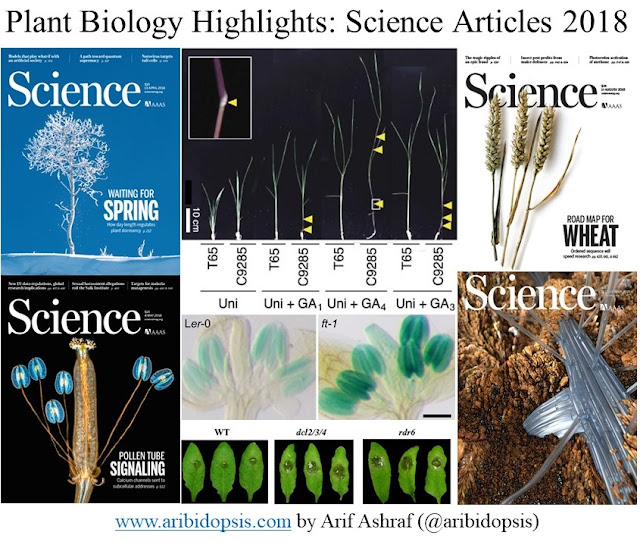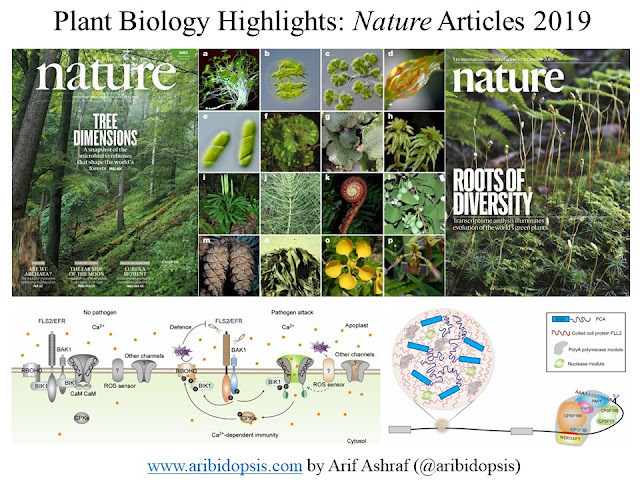Plant Biology Highlights: Science Articles 2018
We are almost at the end of another year. Undoubtedly, we came across amazing research and review articles in this year. As plant biologists, we are more focused on plant-specific journals. Along with those plant-specific journals, plant-related stories are making their place into other journals too. Like previous years, this year also, I'm covering plant biology stories published in Cell, Science, and Nature all the year round. In this post, you'll find published papers from Science.
In temperate and boreal ecosystems, seasonal cycles of growth and dormancy allow perennial plants to adapt to winter conditions. They showed, in hybrid aspen trees, that photoperiodic regulation of dormancy is mechanistically distinct from autumnal growth cessation. Dormancy sets in when symplastic intercellular communication through plasmodesmata is blocked by a process dependent on the phytohormone abscisic acid. The communication blockage prevents growth-promoting signals from accessing the meristem. Thus, precocious growth is disallowed during dormancy. The dormant period, which supports robust survival of the aspen tree in winter, is due to loss of access to growth-promoting signals.
Compared to animals, evolution of plant calcium (Ca2+) physiology has led to a loss of proteins for influx and small ligand–operated control of cytosolic Ca2+, leaving many Ca2+mechanisms unaccounted for. Here, they showed a mechanism for sorting and activation of glutamate receptor–like channels (GLRs) by CORNICHON HOMOLOG (CNIH) proteins. Single mutants of pollen-expressed Arabidopsis thaliana GLRs (AtGLRs) showed growth and Ca2+ flux phenotypes expected for plasma membrane Ca2+ channels. However, higher-order mutants of AtGLR3.3 revealed phenotypes contradicting this assumption. These discrepancies could be explained by subcellular AtGLR localization, and they explored the implication of AtCNIHs in this sorting. They found that AtGLRs interact with AtCNIH pairs, yielding specific intracellular localizations. AtCNIHs further trigger AtGLR activity in mammalian cells without any ligand. These results reveal a regulatory mechanism underlying Ca2+ homeostasis by sorting and activation of AtGLRs by AtCNIHs.
Plants integrate seasonal signals, including temperature and day length, to optimize the timing of developmental transitions. Seasonal sensing requires the activity of two proteins, FLOWERING LOCUS C (FLC) and FLOWERING LOCUS T (FT), that control certain developmental transitions in plants. During reproductive development, the mother plant uses FLC and FT to modulate progeny seed dormancy in response to temperature. They found that for regulation of seed dormancy, FLC and FT function in opposite configuration to how those same genes control time to flowering. For seed dormancy, FT regulates seed dormancy through FLC gene expression and regulates chromatin state by activating antisense FLC transcription. Thus, in Arabidopsis, the same genes controlled in opposite format regulate flowering time and seed dormancy in response to the temperature changes that characterize seasons.
Some pathogens and pests deliver small RNAs (sRNAs) into host cells to suppress host immunity. Conversely, hosts also transfer sRNAs into pathogens and pests to inhibit their virulence. Although sRNA trafficking has been observed in a wide variety of interactions, how sRNAs are transferred, especially from hosts to pathogens and pests, is still unknown. Here, they showed that host Arabidopsis cells secrete exosome-like extracellular vesicles to deliver sRNAs into fungal pathogen Botrytis cinerea. These sRNA-containing vesicles accumulate at the infection sites and are taken up by the fungal cells. Transferred host sRNAs induce silencing of fungal genes critical for pathogenicity. Thus, Arabidopsis has adapted exosome-mediated cross-kingdom RNA interference as part of its immune responses during the evolutionary arms race with the pathogen.
Most plants do poorly when flooded. Certain rice varieties, known as deepwater rice, survive periodic flooding and consequent oxygen deficiency by activating internode growth of stems to keep above the water. Here, they identified the gibberellin biosynthesis gene, SD1(SEMIDWARF1), whose loss-of-function allele catapulted the rice Green Revolution, as being responsible for submergence-induced internode elongation. When submerged, plants carrying the deepwater rice–specific SD1 haplotype amplify a signaling relay in which the SD1 gene is transcriptionally activated by an ethylene-responsive transcription factor, OsEIL1a. The SD1 protein directs increased synthesis of gibberellins, largely GA4, which promote internode elongation. Evolutionary analysis shows that the deepwater rice–specific haplotype was derived from standing variation in wild rice and selected for deepwater rice cultivation in Bangladesh.
To understand evolutionary factors that maintain complex trait variation, they sequenced genomes from a single population of the plant Mimulus guttatus, identifying hundreds of nucleotide variants associated with morphological and life history traits. Alleles that delayed flowering also increased size at reproduction, which suggests pervasive antagonistic pleiotropy in this annual plant. The “large and slow” alleles, which were less common in small, rapidly flowering populations, became more abundant in populations with greater plant size. Furthermore, natural selection within the field population favored alternative alleles from year to year. Their results suggest that environmental fluctuations and selective trade-offs maintain polygenic trait variation within populations and also contribute to the geographic divergence in this wildflower species.
Insect herbivores depend on their host plants to acquire macro- and micronutrients. Here, they showed how a specialist herbivore and damaging maize pest, the western corn rootworm, finds and accesses plant-derived micronutrients. They demonstrated that the root-feeding larvae use complexes between iron and benzoxazinoid secondary metabolites to identify maize as a host, to forage within the maize root system, and to increase their growth. Maize plants use these same benzoxazinoids for protection against generalist herbivores and, as shown here, for iron uptake. They identified an iron transporter that allows the corn rootworm to benefit from complexes between iron and benzoxazinoids. Thus, foraging for an essential plant-derived complex between a micronutrient and a secondary metabolite shapes the interaction between maize and a specialist herbivore.
Animals require rapid, long-range molecular signaling networks to integrate sensing and response throughout their bodies. The amino acid glutamate acts as an excitatory neurotransmitter in the vertebrate central nervous system, facilitating long-range information exchange via activation of glutamate receptor channels. Similarly, plants sense local signals, such as herbivore attack, and transmit this information throughout the plant body to rapidly activate defense responses in undamaged parts. Here they showed that glutamate is a wound signal in plants. Ion channels of the GLUTAMATE RECEPTOR–LIKE family act as sensors that convert this signal into an increase in intracellular calcium ion concentration that propagates to distant organs, where defense responses are then induced.
Plants adapt to heterogeneous soil conditions by altering their root architecture. For example, roots branch when in contact with water by using the hydropatterning response. They reported that hydropatterning is dependent on auxin response factor ARF7. This transcription factor induces asymmetric expression of its target gene LBD16 in lateral root founder cells. This differential expression pattern is regulated by posttranslational modification of ARF7 with the small ubiquitin-like modifier (SUMO) protein. SUMOylation negatively regulates ARF7 DNA binding activity. ARF7 SUMOylation is required to recruit the Aux/IAA (indole-3-acetic acid) repressor protein IAA3. Blocking ARF7 SUMOylation disrupts IAA3 recruitment and hydropatterning. They concluded that SUMO-dependent regulation of auxin response controls root branching pattern in response to water availability.
A hidden cradle of plant evolution in Perminal tropical lowlands
A hidden cradle of plant evolution in Perminal tropical lowlands
The latitudinal
biodiversity gradient today has deep roots in the evolutionary history of
Earth’s biota over geologic time. In the marine realm, earliest fossil
occurrences at low latitudes reveal a tropical cradle for many animal groups.
However, the terrestrial fossil record—especially from drier environments that
are thought to drive evolutionary innovation—is sparse. They presented mixed
plant-fossil assemblages from Permian equatorial lowlands in present-day Jordan
that harbor precocious records of three major seed-plant lineages that all
became dominant during the Mesozoic, including the oldest representative of any
living conifer family. These finds offer a glimpse of the early evolutionary
origins of modern plant groups in disturbance-prone tropical habitats that are
usually hidden from observation.












Comments
Post a Comment